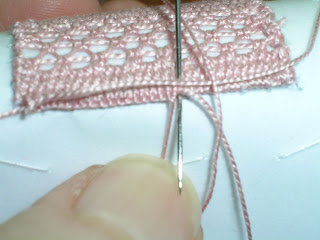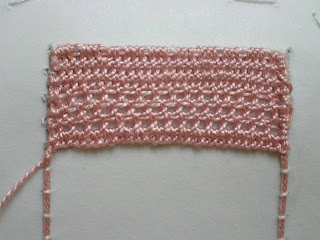 |
| My box of special wire (usually are not as messy!) |
I am afraid that the title of this post DECLARED unequivocally my age. Patience, the similarity with the old song Cocciante was automatic.
The comment Stephanie has left this post prompted me to investigate this issue between the type of wire and the direction in which they work (from left to right or from right to left). So from that time
The embroidery thread, and even pillow and lace, is composed of two (sometimes three) wires, twisted more or less closely. The twist may be of two types: S (clockwise) or Z (counterclockwise). If you take a thread and you look closely, you notice that the diagonal dashes torque can go like this: \\, that is, as the middle part of the letter S, or like this: /, that is, as the middle part of the letter Z.
I made a classification of my wires according to the type of torsion: Torsion
S Moulin, Perl, thread bobbin of Canterbury, embroidery thread.
twist to Z: Cords, real silk.
My theory, to be verified, was that, depending on the type of twist, there were wires more suitable to be processed from left to right and other from right to left. For example, there is a reason why nell'aemilia ars, which works from left to right, using the gimp, while in Burano lace, which you work from right to left, using the Canterbury? If you look at the classification, in fact we see that these two types of wires have a different twist.
In recent days, just as I tried to find their way on this issue, Mary Corbet, in his beautiful, never enough commended blog Needle'n thread, he has written posts on this topic: point steam, punto festone e punto erba .
Lei sostiene che i fili con torsione a S danno un lavoro migliore se lavorati da sinistra a destra, quelli con torsione a Z da destra a sinistra. E qui mi perdo, perchè è esattamente il contrario di quello che si fa nei merletti italiani.
Mi è servito molto il post sul punto vapore. Suppongo che valga anche per i pippiolini: con il cordonetto in effetti vengono bene se lavorati in senso antiorario (torsione a Z), mentre col Perlè e il filo da ricamo vengono meglio in senso orario; non avevo mai capito il motivo, ora lo so.
Torniamo ai nostri merletti. A questo punto, per schiarirmi le idee, ho fatto un esperimento. Here's the photo:
A little 'you see that I have a scientific mind, right?
the top: I have a very twisted Perlè, No. 12; torsion S.
bottom: gimp No. 50 (I found two wires of equal thickness); twist Z.
The first three lines of each champion is worked from left to right, the last three from right to left, all stitch padded.
The effect is certainly different, even a lot, according to the direction of processing. But I do not know which is better. Perhaps the effects are more regular in the first part up and down the last, which would give reason to Mary Corbet.
Can anyone give his opinion?
Another speech is lifted from Stephen: the thread that is rolled on itself, knotting, and continuous needs correcting, or who loses quickly twisting.
The theory is this: the wire with a twist in S, if worked from left to right and tends to accentuate the twist knot, if you work from right to left loses torque (that's Stephen's experience with Perl, which has in effect, a torsion S). The opposite happens with the wire with a twist to Z.
I find that needle lace this problem is less serious than in embroidery because, except in parts very "full" or outline, the wire experiences less friction.
Come potete vedere, resta aperta la questione sul motivo per cui alcuni pizzi si lavorano da destra a sinistra e altri in senso contrario. Forse la torsione del filo non c'entra per nulla e tutto risale a ragioni ambientali, culturali, tradizioni?















































